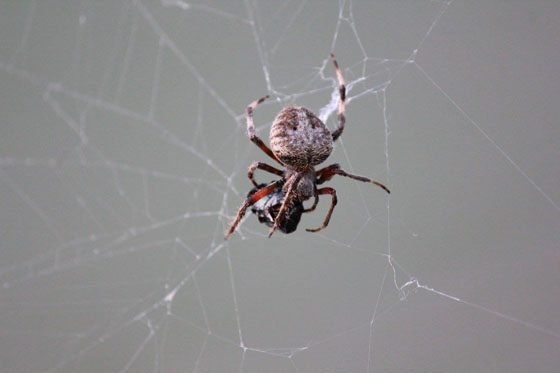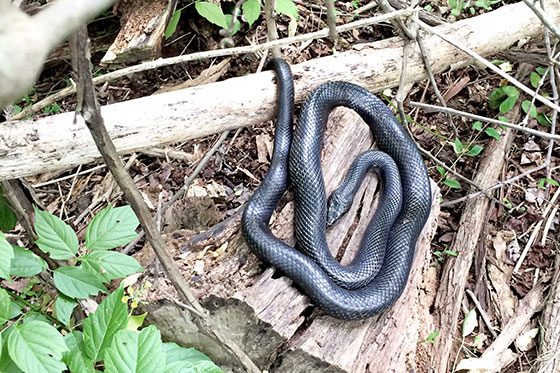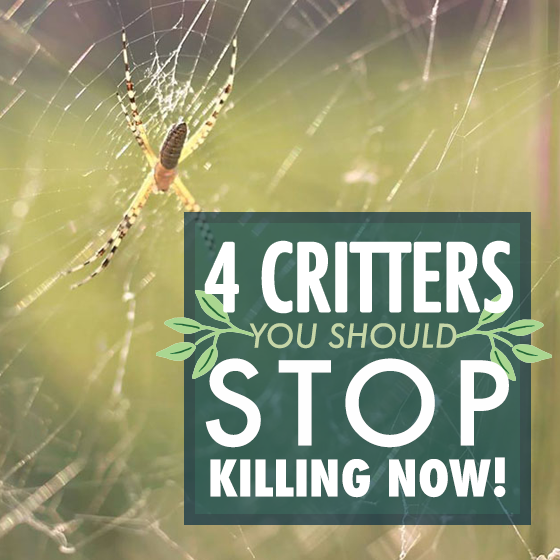Summer has finally arrived, and many of us have been anxiously awaiting the warmer weather that accompanies it. As you spend more time outside, your odds of crossing paths with a creepy-crawly are exponentially increased. The general knee-jerk reaction of most people is to squash first, and ask questions later. Or run screaming. Or scream wildly while you psychotically hack away at the nasty thing with whatever tool is readily available to you, be that a book, your shoe, or your child’s toy. When confronted with even a photo of a spider or snake, most people cringe and comment, “The only good snake/spider is a dead one!” But what many people don’t realize is how beneficial many of these so-called vermin actually are for our ecosystem. Here at Daily Mom, we’d like to encourage you to think twice before you go all Chuck Norris on any of the following critters.
1. Spiders

Okay, so anything with eight legs, eight eyes, and huge fangs would be scary, especially when they set invisible sticky traps at face level and hide inconspicuously inside of every nook and cranny. But did you know that one spider eats around 2,000 insects a year, including disease-carrying mosquitoes and flies? In fact, world-wide, spiders are the single most important element of pest control! Without spiders, our agricultural crops would be devastated by herbivorous insects, and we would be overrun with mosquitoes and other flying pests.
Ecological benefits aside, spiders, though spooky in appearance, are not as harmful to humans as they’re reputed to be. There are over 3,000 species of spiders in North America, and less than a dozen of those pose any threat at all to humans. The best course of action when you come across a spider outside is to simply leave it alone. Learn to recognize the few dangerous spiders, namely the recluse and the black widow; if a dangerous spider is in your home, you can eliminate it by using the hose attachment on your vacuum. If it is outside and near where you or your children play, don’t feel guilty for squishing it; just make sure to take great care in doing so, as these spiders are typically very shy and only bite when they feel threatened. The average home has over 100 spiders inside of it at any given time – keep in mind that they are much more afraid of you than you are of them, and their main concern is eating all the bugs that are crawling around your house, not seeking your destruction.
Keeping Spiders Out of Your House
Obviously, we don’t expect you to read this article and all of a sudden become the spider whisperer, scooping them gently into your palm, cooing sweet nothings to them, and releasing them into the garden as you discover them in your home. We like to think of ourselves as realists here at Daily Mom. We get that, ideally, you’d like nothing more than to never come across a spider inside of your house, period. Spiders are generally less susceptible to chemical pesticides than are the insects they consume, so spraying for spiders is not nearly as effective as you’d imagine. Instead, try some of these chemical-free options:
- Seal up any gaps around doors, windows, vents, and plumbing. Use a caulking gun to fill in any cracks that are allowing spiders into your home.
- The recluse family of spiders are nocturnal, and are not web builders; they love taking cover in piles of clothes, toys, shoes, or stacks of paper on the floor. Your best defense against these spiders is to keep clutter and laundry off the floor.
- Spiders hate peppermint oil. You can make a mix of water with several drops of pure peppermint oil and liberally spray areas where you tend to find spiders in your home. Just be careful not to get the oil spray on children or pets, as it can cause irritation for sensitive skin. Other essential oils that are effective in warding off spiders include citrus, citronella, cinnamon, eucalyptus, and cedar.
- Clean the perimeter of the outside of your home. Avoid piles of wood, rocks, toys, etc. near your house, as those are prime spots for spiders to set up their homes.
- Use cedar mulch in flower beds that lie against your home. Spiders avoid the strong smelling mulch.
- Tidy up. Dust frequently and remove any cob webs you find.
- Place glue traps along the baseboards behind large pieces of furniture. Sure, these are designed for mice, but spiders often travel the perimeter of the room rather than cross a great expanse, and these traps are perfect for stopping them in their tracks. Just be sure to keep them out of reach of children and pets, as the adhesive is extraordinarily strong and messy.
2. Snakes

Snakes are probably one of the most hated and feared of all animals, but most snakes are totally harmless and are extremely beneficial to our environment! In fact, of the 7,000-8,000 snakes bites recorded in the U.S. annually, only about five result in death; compare that to the 4.5 million dog bites, 30-35 of which are fatal every year, and you can see that snakes are much less of a hazard than most people think. Snakes such as garter snakes, rat snakes, corn snakes, and grass snakes eat bugs, rodents, and toads, and the king snake actually hunts down and eats venomous snakes like the copperhead and rattlesnake! Without snakes, we would be quite overrun with mice, rats, and bugs. Most avid gardeners love finding the occasional garter snake in their gardens, as they scare off the rabbits that can destroy plants in no time at all, and they gobble up slugs and bugs that cause damage, too.
A healthy dose of caution is always advised around snakes of any kind. Educate yourself to be able to recognize your region’s venomous varieties by sight, and learn in which areas they are most often found. Typically, the dangerous snakes are masters of camouflage, and blend into their environment seamlessly, so if you know in which areas to be on alert, you’re more likely to avoid contact with one of these guys. Snakes are generally very shy when it comes to people, and the old expression, “They won’t bother you if you don’t bother them” really does hold true. Whenever necessary, call animal control professionals to remove the snake; seventy to eighty percent of venomous snake bites to people occur during attempts to kill the snake.
Avoiding Snakes
Even though the great majority of snakes that come into contact with people are nonvenomous, most people would prefer to never have to deal with them at all. While you can’t totally eliminate the possibility of a snake around your home, you can certainly take some steps to make your property less inviting for them. Also, in the event that you do cross paths with one of these slithering creatures, there are a few good rules of thumb to follow to keep you and your kids safe.
- Keep your lawn mowed. Snakes like the cover of tall grass. When hiking, stay on trails and out of the tall grass, and wear long pants.
- Stay cautious and alert around rocks. Snakes love the hiding places available to them in a pile of rocks, and the heat from a sun-warmed rock attracts them. Many snakes crawl under rocks or wood for protection, so always be wary when upturning large items.
- Eliminate clutter from around your home’s exterior. Piles of firewood, rocks, leaves, or toys make for the perfect hiding place for snakes. It’s a good idea to quickly check inside of outdoor toys, toy boxes, and playhouses before your kids play.
- If you come across a snake, give it plenty of space! Snakes can move very quickly, and can strike up to half the length of their bodies, so be sure to circumnavigate the critter by several feet.
- Eliminate ground-level water sources. Large puddles, bird baths, and ponds attract snakes by offering a drink or drawing in potential prey.
- Eradicate pest problems such as mice and rats. If you’re overrun with rodents, snakes will not be far away.
- Patch up any holes around your foundation, garage, and sheds. Even holes as small as a quarter are large enough for most snakes to enter, so ridding your home of these holes keeps snakes out!
- Yes, we’ve already said this, but the number one way to avoid a tussle with a snake is to leave it alone! These animals go to great lengths to avoid human contact, and when they do meet a person, they make every attempt to dissuade him from coming near. They’re not out to get you… they really want to stay away from you as much as you want to stay away from them!
3. Bees & Wasps

Not much is as horrifying as being dive-bombed by an angry flying insect that has a mind to sting you. Bees and wasps can be found in great numbers throughout spring and summer anywhere that flowers grow. Drawn to all things sweet, they can also be a nuisance at your picnic or around outdoor garbage cans. But these winged insects are crucial to our environment, and too many are being swatted without a second thought. Every piece of fruit, every nut, and every vegetable you have ever eaten… are all thanks to these invaluable pollinators. Bees not only pollinate agricultural crops, but they also provide for us the most delicious of nature’s treats: honey. And wasps are nature’s pest control, killing pest insects that destroy flowers and edibles in your garden. Though the sting of bees and wasps can be quite painful, and for some can cause allergic reactions, when left alone, they are generally only aggressive when protecting their colonies or nests, and can easily live peaceably near your home. Mud daubers are the number one predator for the deadly black widow spider, along with several other pest insects, and are great to have in your garden. Paper wasps love to eat aphids, and hornets like to snack on houseflies.
In late spring and early summer, entire colonies of bees will sometimes swarm in clusters of thousands of bees at a time while searching for a new home. These massive clumps of bees are not dangerous! Honey bees are only aggressive when defending their young or food stores, neither of which do they have with them during a swarm. If you encounter a swarm on your property, consider yourself lucky that you get to witness one of the neatest phenomenons in nature, then call a local beekeeper, who can quickly and easily relocate the swarm to a new nesting site.
Living in Harmony with Bees & Wasps
We are sure by now you’re noticing a theme when it comes to dealing with these misunderstood creatures: give them their space, and let them be. Bees and other pollinators are quite possibly the most essential of all of earth’s critters. Other than the yellow jacket, these insects truly avoid confrontation with people unless they sense a threat to themselves or their nest. Here are a few pointers for coexisting with these guys:
- Don’t swat at bees and wasps. If one lands on you, calmly brush it off and walk away. Bees can only sting once, and to do so will kill it, so it would much prefer to not sting you.
- If you notice a wasp nest, avoid it completely. Oftentimes, wasps choose pretty inconvenient (for us) places to build their nests, such as the eaves of our homes or behind fence posts in our yards. If these nests are in highly traveled areas, you’re likely going to need to remove it. If so, you can call a professional pest control service, or you can use a spray product designed to kill the wasps on the nest. Just beware: any wasps not immediately killed will come after you in defense of their nest, so calling a professional who is equipped to safely remove nests is the best option.
- When planning to be outdoors where bees and wasps are plentiful, avoid lotions, hair products, and perfumes that are strongly scented… pollinators are attracted to the floral scent.
- Keep garbage cans tightly closed. Yellow jackets are scavengers, and will be attracted to the smell coming from your trash.
- Most wasps are highly territorial, and will not build a nest where one already exists. In early spring, you can place one of these imitation paper nests on your porch or under your eaves to deter wasps from building any new nests near your home. If a large nest already has been established, however, you will need to have it removed before the imitation nest will work.
- Find your local beekeepers’ contact information, and keep it handy in the event that you need a bee colony moved from near your home. Bees can sometimes nest inside of hollow walls, gaining access through small holes or cracks in siding, or inside of rotting trees. It’s much more desirable for a beekeeper to safely move the colony than to exterminate it.
4. Bats

Admittedly, anything that only comes out at night and looks like it belongs in a vampire movie can elicit fear in even the bravest of souls. But bats are mighty bug hunters that can eradicate upwards of 1,200 insects per hour! One of their very favorite snacks is the mosquito. In fact, bats are such good exterminators that a large bat colony can reduce the amount of pesticides required by farmers, keeping insect damage to crops at a minimum.
Many people fear bats because they can be carriers of rabies; while this is true, the fact is that bats are far less likely to carry or spread the disease than most other mammals. Rabies affects bats so quickly that the animals typically die before they even exhibit any aggression, and only less than half of one percent of bats carry the disease. Bats are nocturnal and generally very shy, which means handling a bat is nearly the only way to be bitten in the first place.
Fun Bat Facts
- Bats are not blind as often thought; they use echolocation to bounce high-frequency squeaks off of the environment around them, using the echo to navigate. This is also how they find their prey. They may look like they’re flying all willy-nilly, but they’re actually very strategic flyers and avoid people (we’re too big to eat).
- Bats are losing their natural habitats, such as caves and dead trees, which drives them to seek shelter in attics and old buildings. You can provide a bat house on a tall pole or under the eaves of your home or a building; bat houses can provide a home for up to 100 bats! Even a small colony of bats on your property will help keep disease-spreading mosquitoes at bay!
- All bats found in the U.S. feed exclusively on insects, but some bat species around the world play an essential role in pollination.
- Bats are the world’s only flying mammal!
- Bats usually only have one baby, or pup, at a time per year.
- A huge colony of Mexican free-tails in Bracken Cave, TX eat almost 200 tons of bugs every night!
- The saliva of vampire bats is being used to create an anticoagulant drug for beating blood clots in stroke patients.
- The smallest bat is only about 2 oz, and the largest is over 2 lbs!
Okay, You Can Squish These:
While it can be argued that every living thing, no matter how large or small, has a part to play in our ecosystem, some of these critters actually do more harm than good where human health is concerned. Hopefully, you have learned a few things about spiders, snakes, pollinators, and bats to keep you from automatically annihilating them when you meet them, but we give you permission to smash the following:
- Roaches: These creeps spread over 30 different types of bacteria, and the filth they leave behind (their shed skin and feces) triggers allergies and asthma, especially in kids. Roaches are very hard to eradicate… they can live for over a month without food, and for over a week without their heads! A female roach can mate once and remain pregnant for the rest of her life, infesting your home with thousands of her offspring. Spiders, snakes, and bats eat these… just sayin’.
- Mosquitoes: These flying pests are associated with more deaths all over the planet than any other living creature. From malaria and West Nile, to the newly discovered Zika virus, these bugs transmit diseases by biting and sucking the blood from their victims. Have pets? Mosquitoes even transmit heartworms to our fur babies. Spiders and bats are the two biggest eaters of mosquitoes!
- Termites: These tiny ant-like critters are awesome as nature’s clean-up crew; they break down fallen trees and stumps in no time. But in our homes, their natural behavior is extremely destructive, so they’ve gotta go!
- Mice and rats: These guys are nasty, and their feces and urine deposits carry and spread over 50 devastating diseases. Plus, they are destructive, chewing through walls and wires! Mice and rats are suspected as the cause of over 1/4 of all house fires for which the cause could not be identified. You know those snakes you are so afraid of? They love eating mice and rats.
Now that you’ve got your critters under control, check out 4 Natural Ways to Keep the Bugs Away.
Photo credits: Cindy Haley, Sarah Coggins, Gilles San Martin










































